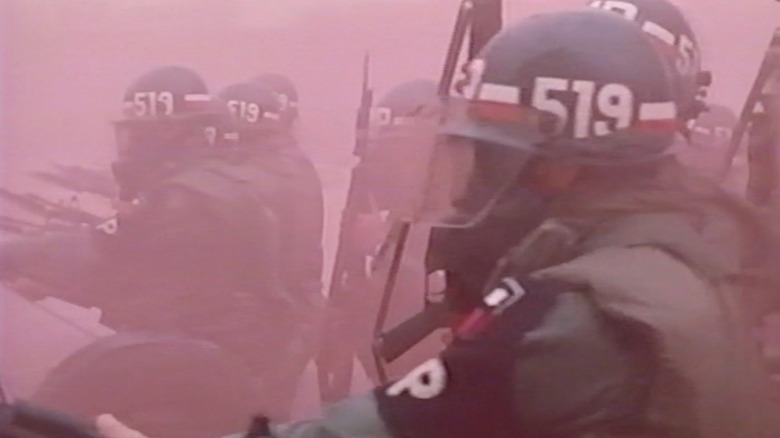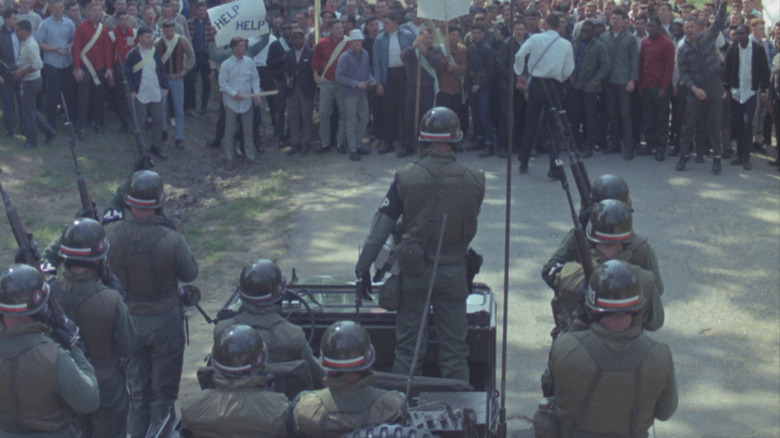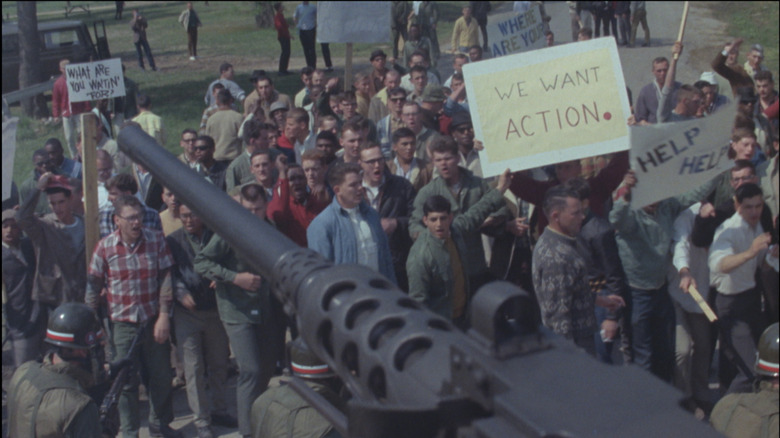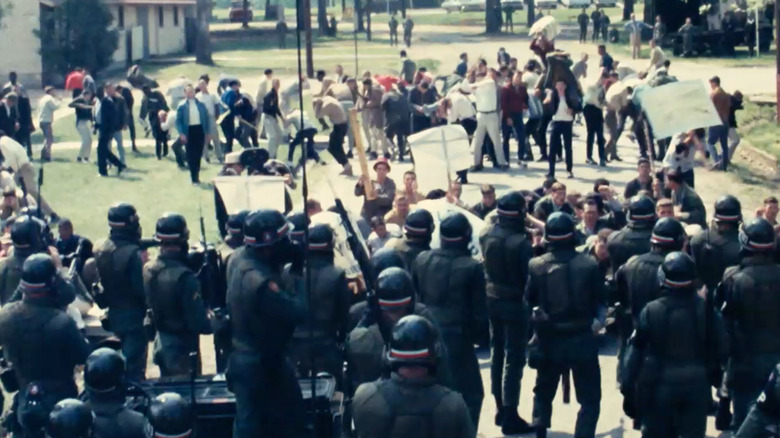Riotsville, USA Review: A Stark, Damning Archival Documentary About Institutional Control In America [Sundance 2022]
There's a found footage horror movie atmosphere blanketing "Riotsville, USA." There's nothing supernatural here, though; all the horrors are earthbound. And unlike found footage horror, "Riotsville" is real. Using only archival footage, filmmaker Sierra Pettengill has pieced together an unsettling documentary that reminds us that the more things change, the more they stay the same. Since the footage is culled together from the past, it is presented to us in a grainy, blurry, static-heavy state. Editor Nels Bangerter pieces it all together and recontextualizes the footage, making use of those awkward, silent moments before the action begins, where newsmen scratch their noses and adjust their neckties. Where people who aren't aware they're being filmed still take their places; players in a bit of theatre being staged by unseen forces. All of this mixed media swirls about, taking shape, resembling something dark and ominous, like a work of Americana constructed by John Carpenter in his heyday.
In the 1960s, the United States underwent a seismic shift that inspired disaffected, disenfranchised citizens to take to the streets in protest. Many of those protesting were Black citizens and other minority communities tired of waiting for the country to recognize their Civil Rights. "The people took revenge on the cities that confined them," a narrator (Charlene Modeste) tells us early on. With threats of civil unrest rising, the government was spurred to act – but not in the way many of the American people had hoped for. In 1967, an entire fake town, dubbed Riotsville, was constructed on a military base. The purpose: to train the military and law enforcement officers on how to deal with uprising citizens rioting.
But that wasn't the only government action – that same year, President Lyndon B. Johnson started a commission to investigate civil unrest in cities. Johnson's motives weren't entirely pure: he was hoping the commission would confirm his belief that "outside agitators" were the real cause of rioting. And to be sure that the boat wouldn't be rocked too hard, Johnson only appointed political moderates to the commission, which was officially dubbed The National Advisory Commission on Civil Disorders but became known as the Kerner Commission, after its chairman, Governor Otto Kerner Jr. of Illinois.
A year later, the commission's report was in – and it was damning. The commissioners pointed out what Black activists had already been saying: much of the unrest was fueled by the inherent racism built into American society. One line of the report summed things up succinctly: "Our nation is moving toward two societies, one Black, one white – separate and unequal." Spanning 700 pages with 300 footnotes, the report was "a picture of social collapse" – and a bestseller, too. When published in paperback form, the report flew off the shelves. Again: nothing in the report was new. But now, it wasn't just Black activists shining a light on the problem – it was a group of white moderates, and they were putting it all down on paper. Surely, something had to change, and change for the better. Right?
A Door Sprang Open
Of course, it didn't. While the report offered solutions to these problems, those solutions would not be cheap – an estimate placed the cost of such sweeping changes at something like $2 billion a week, which was akin to what the government was spending on the Vietnam War. The argument that arose was that Johnson and company could barely handle the Vietnam War – how could they handle this, too? That is, of course, a nonsensical argument; a cop-out; a politicians' way of throwing up their hands and saying, "Look, we barely tried. What more do you want from us?" At the same time, the report was not without its own flaws. The commissioners attempted to downplay any talk of revolution and wrote things off as a "string of nameless riots," unconnected by anything, which simply wasn't true. In the end, almost everything in the report was ignored – with one key exception. An addendum called for "extensive new federal funding for police." This was what the powers-that-be chose to embrace. Why should America attempt to solve the problem when it could just turn its police forces into foot soldiers in a heavily-armed war against its citizenry instead?
"Riotsville, USA" recounts much of this both via narration and some on-screen text that helps us along the way, and these elements can often dilute the film's impact. It starts to feel like hand-holding and the prosy style of narration – "A door sprang open in the 60s, and someone, something, sprang up to slam it shut!" we're told at the start – will on occasion grow distracting. But the footage remains, and the footage is what holds our attention, painting a bleak portrait of America as a country that seems to have no real solutions other than excessive, violent force. "Riotsvilla, USA" wisely avoids bluntly connecting the events of the film with our current political landscape, primarily because it doesn't have to – we can see the connections plain as day, and they are stark.
At one point, the film cuts to a TV segment on the now-defunct Public Broadcast Laboratory, a forerunner for PBS. The segment has cops from around the country and Black activists addressing the subject of police brutality. If I told you that every single policeman interviewed categorically denied the existence of police brutality, would you be shocked? Probably not. It has become the standard refrain for not just law enforcement, but also morally bankrupt bootlickers who back them no matter what: the police are blameless, and anyone who dares to even slightly disobey them deserves to be punished in the most extreme ways imaginable.
Soldier Boy
As this all unfolds, Pettengill continually returns to Riotsville. We learn a second location was built, and we watch as military men in street clothes play-act as protestors. They shout, and hold up fake signs, and clearly don't take any of this very seriously. Riotsville itself is like the set of some low-budget Western, full of false-front buildings with hand-painted signs. Windows are smashed and items are looted, but none of it is real. It's all an act. There is nothing to truly be learned by this simulation, where none of the protestors actually believe in anything they're saying. From bleachers, men in uniforms or suits watch, bemused. They all seem to have the same ruddy, fleshy, jowly face. They all have the same smirk. They laugh and applaud as a "protestor" is loaded into a van and driven away, promising he'll return with his friends. It's a game.
It was also an excuse to increase military spending. There was apparently no money to intact the potentially helpful changes outlined in the Kerner Commission report; changes that had the chance of benefiting Black communities. But there was plenty of cash available to build things like a tank dubbed the Witch Craft. It looks like an ice cream truck from hell; a white blocky box on tank treads, rolling about and spewing incest repellant at people.
Again and again, the bleak truth is driven home: this is the society America built. One where helpful solutions are ignored as unrealistic, and violent action reigns supreme. Riotsville is a dream; a nightmare. It's a movie backlot that doubles as a boot stomping on anyone who dares to dissent. It's hard not to succumb to the hopelessness of it all, and Pettengill underlines the dark absurdity of it all, such as during a scene where a montage of soldiers play-acting in Riotsville is scored to The Shirelles belting out the tune "Soldier Boy."
The Major Unfinished Business of This Nation
While "Riotsville, USA" hammers its point home again and again, it also occasionally feels adrift. The film's continual focus on the Public Broadcast Laboratory comes across as half-baked, and a big finale set during the 1968 Republican National Convention in Miami Beach is rather limp, lacking the forceful punch of much of what came before. But the harsh realities of the proceedings lingers. That "found footage" vibe prevails – and like so many found-footage flicks, things here feel dire; hopeless. After all, the footage wouldn't be considered "found" unless someone discovered it after the fact – when it was all too late. When the window of escape has long since been closed and latched. But windows were made to be broken – with bricks hurled forth from furious crowds, fed-up at being treated as second-class, or lower.
In one moment of macabre humor, we watch as white grandmothers and housewives, terrified and whipped into a frenzy by racist politicians, line up to buy guns and shoot them at targets. These women laugh and crack jokes; they grin at the camera as they say they don't want to shoot anyone, but they will. This immediately cuts to footage of a Black woman who points out that if a Black politician told Black people to go out and start arming themselves for protection there would be a huge outcry.
More than 50 years later, the specter of Riotsville lingers – a haunted, absurd place where those in power control everything and everyone. Where any sort of push-back is considered to be a fluke; something that just happens. On the dusty streets of Riotsville, LBJ's dreams of "outside agitators" became a reality. Nothing was real, and everything was under control. When the Kerner Commission report arrived, it stated: "It is time now to turn with all the purpose at our command to the major unfinished business of this nation. It is time to adopt strategies for action that will produce quick and visible progress. It is time to make good the promises of American democracy to all citizens – urban and rural, white and Black, Spanish-surname, American Indian, and every minority group." Even though he was the one who ordered the report, Lyndon Johnson (and every other politician) chose to ignore these words. Five decades later, America is still ignoring them.
/Film Rating: 8 out of 10



